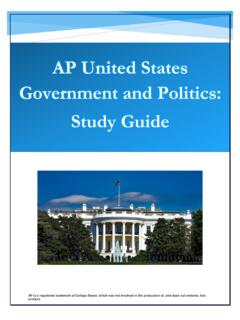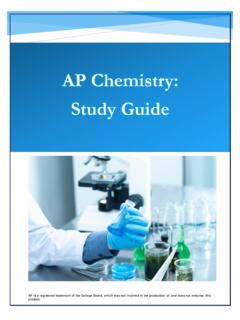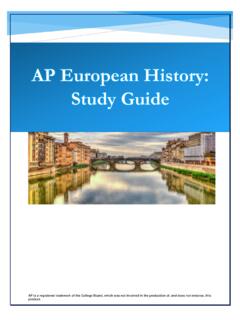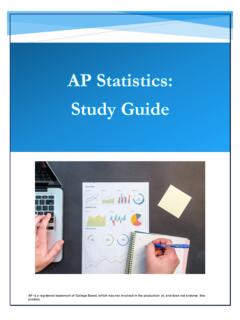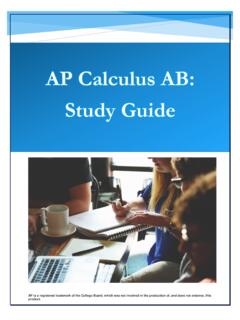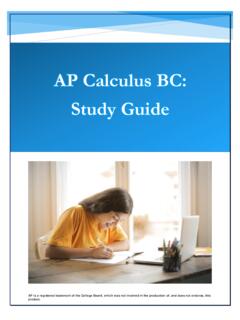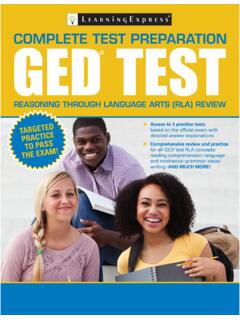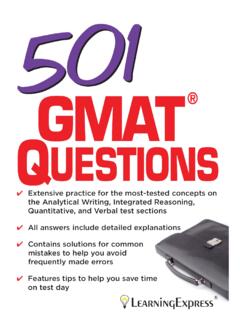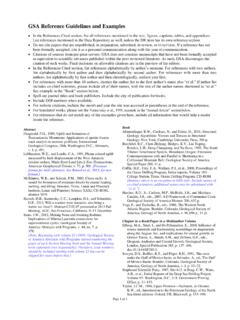Transcription of AP European History: Study Guide - EBSCO Connect
1 AP European History: Study Guide AP is a registered trademark of the College Board, which was not involved in the production of, and does not endorse, this product. Key Exam Details The Advanced Placement (AP) Program is designed to allow high school students to pursue college-level studies while attending high school.
2 Colleges use AP scores to determine students eligibility for advanced course placement and/or course credit. On your AP European History exam, you can expect to find multiple-choice and short-answer questions that focus on the following themes. Each theme will make up 10 15% of all exam questions: Renaissance and Exploration (c. 1450 c. 1648) Age of Reformation (c. 1450 c. 1648) Absolutism and Constitutionalism (c. 1648 ) Scientific, Philosophical, and Political Developments (c. 1648 ) Conflict, Crisis, and Reaction in the Late 18th Century (c.)
3 1648 ) Industrialization and Its Effects (c. 1815 c. 1914) Nineteenth-Century Perspectives and Political Developments (c. 1815 c. 1914) Twentieth-Century Global Conflicts (c. 1914 present) Cold War and Contemporary Europe (c. 1914 present) The exam also includes a document-based question and a long essay question, each of which test your ability to consider a history-based prompt and write a response that: Provides a strong thesis Places the topic in context Offers compelling evidence Shows logical analysis and reasoning This Guide will give you a review of all major exam topics, with an emphasis on the key people, places, events, and documents of each time period.
4 Following every topic overview are sample AP multiple-choice or short answer exam questions, so you can get a sense of how information will be presented on test day. Let s get started! 1 Renaissance and Exploration People of Interest Renaissance: Petrarch, Leonardo da Vinci, Michelangelo, Raphael, Erasmus, Machiavelli New monarchs: Charles VII, Louis XI & Francis I of France, Henry VII & VIII of England, Ferdinand of Aragon & Isabella of Castile Explorers.
5 Christopher Columbus, John Cabot, Ferdinand Magellan Technological pioneers: Johannes Gutenberg Key Concepts Humanism: Humanism underpinned the Renaissance and shifted focus away from contemplation of the Divine to consideration of humanity, albeit still in the context of a divinely appointed universe. The Italian Renaissance tended to place greater emphasis on classical texts, while scholars of the Northern Renaissance, such as Erasmus, tended to place more emphasis on these in combination with early Christian works.
6 By questioning the authority of that which had arisen in between, this helped pave the way for the Reformation, as well as the Scientific Revolution and the Enlightenment. New monarchies: a new form of monarchy emerged in Western Europe in the late fifteenth century, which, by engaging in state-building, laid the foundation for modern states ( , England, Spain, and France). Mercantilism: an economic theory popular in the early modern era, mercantilists advocated efforts to build up exports and reduce imports through protectionism, in order to maximize the accumulation of wealth, which was identified as the treasure stored in a land s coffers.
7 Key Terms Vernacular: the native language of a locality, which allowed authors to reach a broader section of society than Latin did, and promoted the development of local culture. 2 Living off their own : the medieval tradition that monarchs should fund their activities from their private income while at peace and only impose taxes when at war.
8 Intercursus Magnus: Henry VII s trade deal with Burgundy, which included beneficial terms for English merchants. Columbian exchange: the term used to describe the transfers of goods, people, culture, and diseases between the Old World and the New, which occurred in the wake of Columbus s exploratory voyages. Putting-out system: the system whereby entrepreneurs would deliver materials to their workforce outside town to avoid profit-inhibiting guild regulations, and return to collect the finished goods before selling them on in town.
9 Joint-stock company: formed when adventurers would subscribe money together to fund an enterprise that they either did not wish, or were unable to, fund individually; returns from the venture would then be divided up in proportion to the original investment. Timeline 1345: Petrarch discovers a copy of Cicero s letters to Atticus : Gutenberg press begins working on the Gutenberg Bible, its first publication 1477: Death of Charles the Bold returns Burgundy to Louis XI of France 1479: Castile and Aragon are united in a personal union under Ferdinand and Isabella 1485: Henry VII of England ends the Wars of the Roses 1492: Ferdinand and Isabella fund Christopher Columbus s first voyage to the New World : Both Leonardo da Vinci and Michelangelo are active in Florence 1511.
10 First publication of In Praise of Folly by Erasmus 1518: A Hispaniola Smallpox outbreak epitomizes spread of disease from Old to New Worlds 1532: Publication of The Prince by Niccol Machiavelli 1550s: Portuguese begin transporting Africans to Brazil as slaves 1560s: Spanish begin convoy system to protect their trade with the Americas 3 Classical Revival and Renaissance Developments The Renaissance stemmed from a revival of interest in classical
